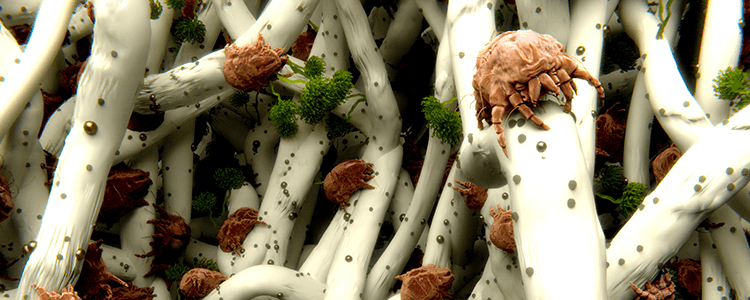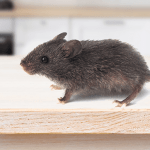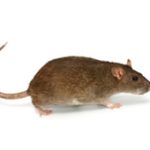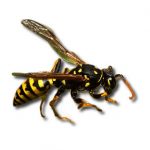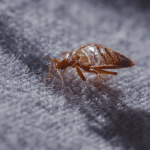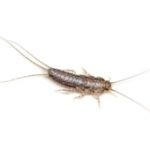Dust mites in UK homes
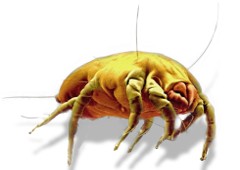 Although not commonly regarded as pests, dust mites are health-threatening Arachnids found in nearly every household across the UK. These microscopic creatures are closely related to ticks and chiggers. The most common species found in British homes is Dermatophagoides pteronyssinus. However, the term “dust mites” broadly refers to various types of arachnids that thrive in indoor environments and feed on dust, dead skin flakes, and organic debris. Due to the UK’s humid climate, these conditions are ideal for house dust mite growth and spread, especially in homes with carpets, bedding, and upholstery.
Although not commonly regarded as pests, dust mites are health-threatening Arachnids found in nearly every household across the UK. These microscopic creatures are closely related to ticks and chiggers. The most common species found in British homes is Dermatophagoides pteronyssinus. However, the term “dust mites” broadly refers to various types of arachnids that thrive in indoor environments and feed on dust, dead skin flakes, and organic debris. Due to the UK’s humid climate, these conditions are ideal for house dust mite growth and spread, especially in homes with carpets, bedding, and upholstery.
Image by: Gabriel Escobedo
Where do dust mites live in the UK & What do they eat?
Dust mites in the UK are found in homes year-round, thriving particularly in humid environments and poorly ventilated indoor spaces. These microscopic arachnids are cosmopolitan and exist on every continent, including the Antarctic, thanks to human presence. However, their population drops in high-altitude or dry climates. In the UK, they favour high-moisture areas such as carpets, bedding, mattresses, and upholstered furniture – all common in British households.
A single mattress can harbour up to 10 million dust mites species making your bed one of the most concentrated habitats for these pests. When disturbed, dust mites in mattresses and sofas avoid strong light, retreating deeper into the fibres. Their diet consists mainly of shed human skin cells, secretions, house dust, pollen, fungal spores, and other organic debris. This makes UK homes with central heating and soft furnishings an ideal environment for dust mite infestations.
How dust mites affect your health
Dust mites are one of the most common indoor allergens in the UK, triggering a wide range of health problems. Numerous scientific studies – some dating back to the 1960s – have established a strong link between exposure to dust mites and allergic reactions. The allergenic potential comes not only from the mites themselves but also from their faeces and shed skin particles, which easily become airborne and inhaled.
While dust mites do not bite nor sting, and are not known to carry any diseases, they can cause serious health issues, particularly for people with asthma, eczema, or allergic rhinitis. Common dust mite symptoms include sneezing, itchy eyes, congestion, skin irritation, and coughing. In warmer, more humid environments, like many homes in the UK, 70–80% of allergy sufferers react to dust mite allergens. Those with pre-existing respiratory issues should be especially cautious, as dust mite allergies in the UK are a significant concern for many households.
Can you see dust mites? Signs and identification tips
Can you see dust mites? Not with the naked eye. These microscopic creatures measure only about 0.5mm in length, making them incredibly difficult to detect without magnification. Dust mites have white, oval-shaped bodies with eight legs, and due to their small size, they often go unnoticed in most households.
Dust mites remain invisible throughout their lifecycle, hiding deep within bedding, carpets, and upholstery. For those wondering what dust mites look like, the answer typically requires a microscope. Only a few specialised laboratories possess the expertise and equipment necessary for the proper identification of these microscopic Arachnids.
Dust mite control in humid UK homes
Dust mite control is especially important for asthma sufferers and dust allergies. To reduce exposure, it’s vital to limit the surfaces that provide a suitable habitat for dust mites in UK homes, particularly in areas of high humidity.
Carpets, upholstered furniture, and cotton draperies should be avoided, as these are common breeding grounds. Instead, opt for leather furniture and anti-allergen mattress covers. Many asthma patients now use special hypoallergenic mattresses and bedding that are designed to resist dust mite infestations. If you’re wondering how to get rid of dust mites, it often starts with making your home less hospitable – maintaining low humidity, vacuuming regularly with a HEPA filter, and washing bedding at 60°C can all reduce their numbers.
How can you tell if you have dust mites in the UK?
Although dust mites in the UK are invisible to the naked eye, their presence is usually indicated by allergic reactions such as sneezing, coughing, watery eyes, or worsening asthma symptoms, particularly in the bedroom. These microscopic arachnids often thrive in pillows, mattresses, and soft furnishings, where they feed on dead skin cells and moisture from our bodies.
How can you clean your house of dust mites?
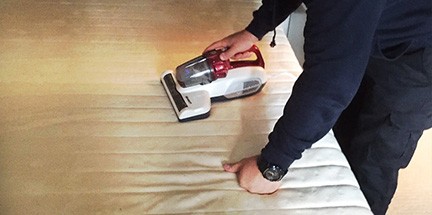 Dealing with a dust mite infestation can be frustrating, especially in humid homes across the UK where these microscopic pests thrive. Unfortunately, dust mites are almost impossible to exterminate, as they are not insects and therefore unaffected by typical over-the-counter insecticides. However, regular and thorough cleaning is key to minimising dust mite infestations. Vacuuming carpets and upholstery with a HEPA-filter vacuum, washing bedding at 60°C, and using anti-allergy mattress covers can all reduce their numbers. Also, consider using a UV vacuum cleaner, which can both kill mites and prevent them from becoming airborne.
Dealing with a dust mite infestation can be frustrating, especially in humid homes across the UK where these microscopic pests thrive. Unfortunately, dust mites are almost impossible to exterminate, as they are not insects and therefore unaffected by typical over-the-counter insecticides. However, regular and thorough cleaning is key to minimising dust mite infestations. Vacuuming carpets and upholstery with a HEPA-filter vacuum, washing bedding at 60°C, and using anti-allergy mattress covers can all reduce their numbers. Also, consider using a UV vacuum cleaner, which can both kill mites and prevent them from becoming airborne.
How to avoid house dust mites?
To avoid dust mites, it’s essential to control indoor humidity, ideally keeping it below 50%. Replace heavy curtains with blinds, choose leather or synthetic furniture, and regularly air out rooms. These steps create an environment that is less hospitable to dust mites in the UK, especially in homes prone to high humidity.
Keep in mind that we only aim to provide some useful information about dust mites in general. We cannot guarantee that what you’re dealing with corresponds to the same description.



